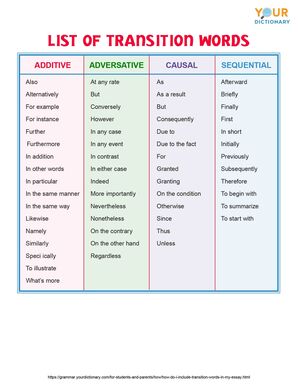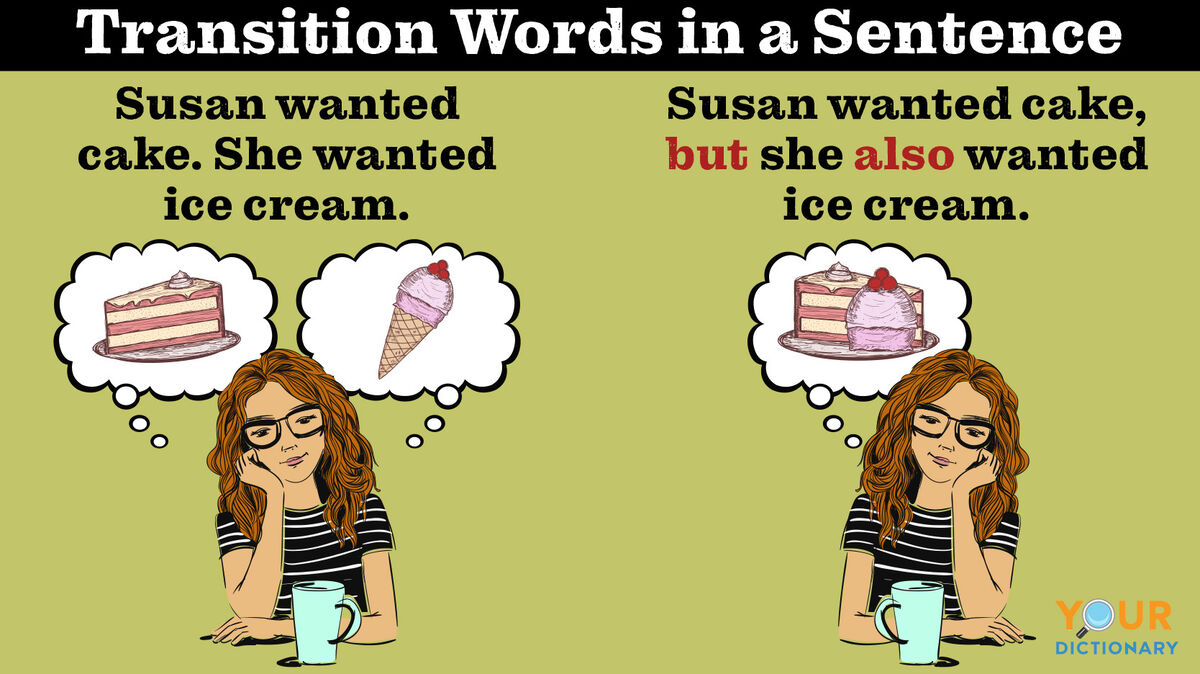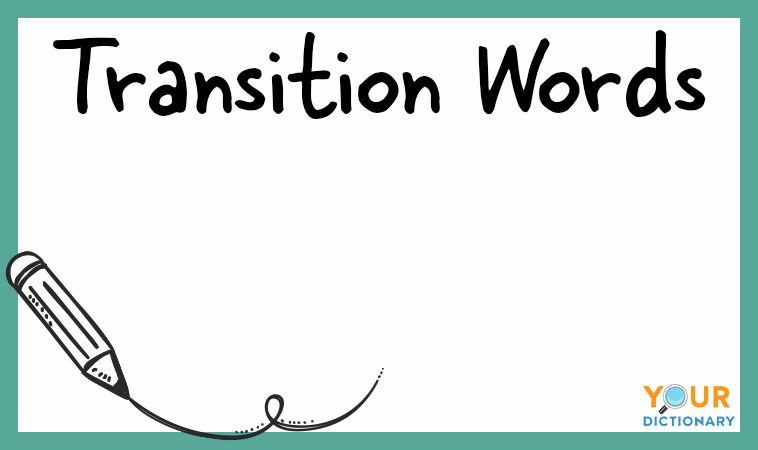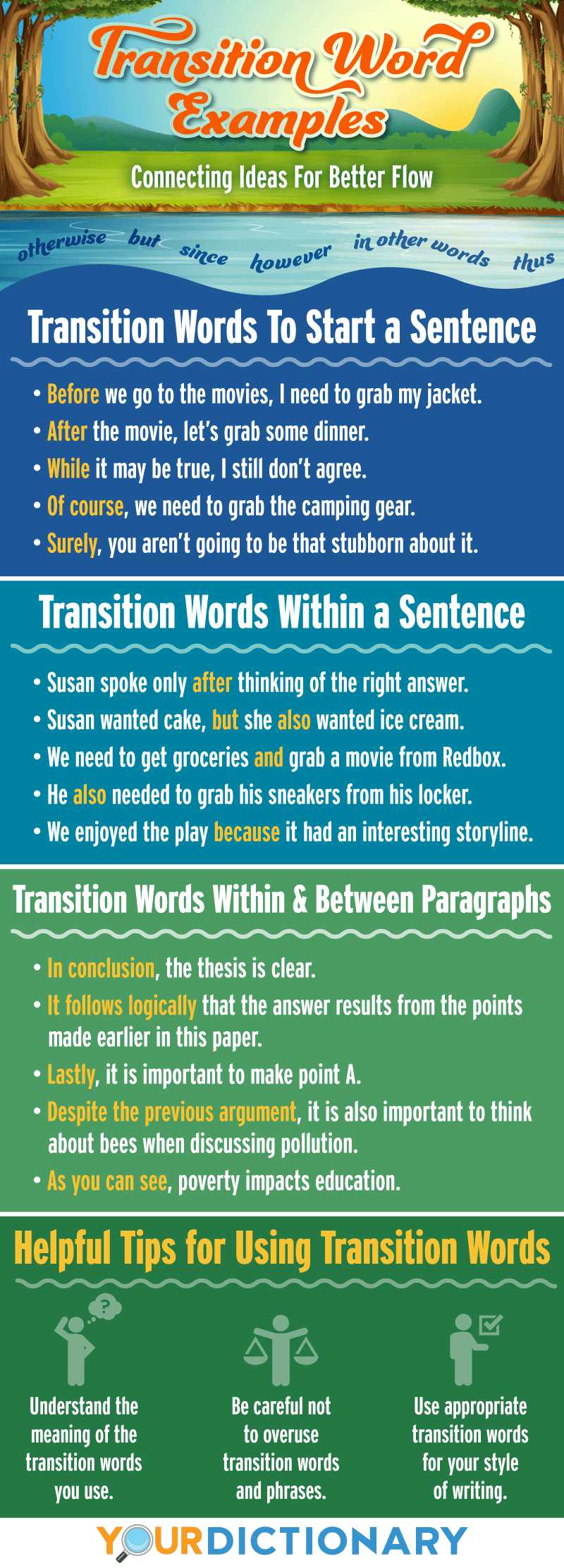

Transitional words and phrases help make a piece of writing flow better and connect one idea to the next. Because there's more than one way to connect ideas, there are many types of transitional phrases to show a variety of relationships. View several transition words and examples of phrases used in sentences, paragraphs and essays.
What Are Transitional Words and Phrases?
So, what are transition words? Well, transition words work to connect thoughts, sentences and paragraphs together. Transition words are important within a sentence or paragraph because they allow your arguments to flow seamlessly from one sentence or thought to another. When introducing transition words, the most basic transition words are conjunctions that join words, phrases or clauses together. For example, words like and, but and or can connect two sentences together.
- I ran home, and I got there just in time. (and is a transition word that connects the two occurrences equally)
- I ran home, but I was still late. (but introduces a contrast)
- I could run home, or I could stay at school and work. (or presents two different options)
As you can see in the examples above, even simple conjunctions serve different purposes. Knowing the different categories of transition words, which you'll see below, will help you choose the ones that best get your point across.
Other transition words are adverbs that describe the way an action is performed or how it relates to another idea.
- I went to the mall after he gave me my paycheck.
- Bowling is a sport in which the player with the highest score wins. Conversely, the goal in golf is to get the lowest score.
- First, we are going fishing. Then, we will get ready for dinner.
Paragraph Example With Transition Words
Simple transition words don’t just work on a singular sentence level. They can work to bring together an entire paragraph. Read through the paragraph without transition words. Then, look at the same paragraph with transition words added. Do you see how the example without transition words is choppy and abrupt? Transition words help your thoughts flow from one idea to the next and connect sentences for conciseness.
| Paragraph Without Transition Words: Drawing is all about taking the time to master each step. Mastering the art of drawing doesn’t happen in a day. It’s a skill that takes daily practice. You need dedication to hone your craft. It’s important not to burn yourself out. You need to stick with it. | Paragraph With Transition Words: Drawing is all about taking the time to master each step. In other words, mastering the art of drawing doesn’t happen in a day. Furthermore, it’s a skill that takes daily practice as well as dedication to hone your craft. It’s important not to burn yourself out, but you need to stick with it. |

Types of Transition Words and Phrases
There are several types of transition words and phrases, and each category helps the reader to make certain connections. Some signal the building of an idea, while others help readers compare ideas or draw conclusions. Here is a list of transition words and common transition sentence examples.
Type | Definition | Sentence Examples |
compare/contrast | point out alternatives or differences |
|
chronology | help define time |
|
cause/effect | show the consequences of an action |
|
illustration/examples | add emphasis or introduce evidence |
|
addition | add information or reinforce ideas |
|
clarification | show support |
|
qualification | present conditions or intentions |
|
summary/conclusion | restate ideas |
|
sequence | shows order |
|

Types of Transitions in Writing
When it comes to the creation of essays and papers, using transitions becomes more important. You need to use transitions within and between sentences, to connect paragraphs and to connect whole sections of an essay. See how transition words and phrases work to connect sentences, paragraphs and sections through examples.
Transitions Within Sentences
Transition words can be used to connect thoughts within a sentence. This transition highlights chronology or the order in which events occurred. Check out these transition word examples.
- Original: Susan spoke up, thinking of the right answer.
- With Transitions: Susan spoke up after thinking of the right answer.
- Original: Susan wanted cake. She wanted ice cream.
- With Transitions: Susan wanted cake, but she also wanted ice cream.
- Original: Drawing takes talent. Drawing takes dedication. Everyone can learn to draw.
- With Transitions: While it may be true that drawing takes talent and dedication, everyone can learn to draw.
Transition Words Between Paragraphs
When transitions are used between paragraphs, they are often in the form of a phrase or clause that refers to the previous information while introducing a new idea. These transitions often come at the beginning of new paragraphs. See how this works by exploring these transition sentence examples.
- In conclusion, the thesis is clear.
- It follows logically that the answer results from the points made earlier in this paper.
- Lastly, it is important to link all these points together.
- Next, we will look at the evidence for improving nutrition in schools.
- Despite the previous argument, it is also important to think about bees when discussing pollution.
Examine how this works through a longer paragraph example. Notice how the transition words and phrases make the flow from one paragraph to the next seamless.
Lastly, the effect poverty has on education needs to be examined. Many students below the poverty line do not have access to transportation and other resources that allow them to take advantage of school of choice. Additionally, the services available through programs within their area are lacking. It follows logically that these students lack access to quality education and services students in middle class homes have.
As you can see, poverty can have an impact on several aspects of an individual’s life. Not only does it impact their work and home life, but their education as well. Therefore, as a community, it’s pivotal to provide advanced services and assistance to individuals in lower-income areas.
Transitions Between Sections
When writing a longer essay or research paper, it’s important to use transitions to link one section to another. Not only do you use transition words to create this section, but the paragraph itself is a transitional paragraph. Here's what a transition paragraph might look like.
In the previous section, this study explored the demographics of the Chicago, Illinois area. Understanding the diversity of the population throughout the area is particularly important to dissecting the implementation of after-school programs. In the following paragraphs, the study will consider the importance demographics play in understanding the need-based programs.
Using Transition Words
If you want a quick reference guide for using transition words in sentences, paragraphs and papers, this infographic is the perfect tool.

Signs You Need Transition Words
When students start out as writers, it can be hard to know exactly when to use transition words. However, there are a few things you can look for to know when you should include transition words in your essay.
1. Section Sounds Choppy or Abrupt
If the paragraph or sentence you are writing sounds abrupt, transition words are needed.
- Original: Michael didn't have enough money to buy his mom flowers. He wasn't old enough to get a job. He felt sad on Mother's Day.
- With Transitions: Michael didn't have enough money to buy his mom flowers because he wasn't old enough to get a job. Nevertheless, he felt sad on Mother's Day.
2. Trouble Following Train of Thought
While writing without transitions can be abrupt, it can also be confusing. It’s important to guide readers from one thought to the next.
- Original: Tracy did not have money. Jill had money. Tracy bought a gift for her mother.
- With Transitions: While Tracy did not have money, Jill did. Therefore, Tracy bought a gift for her mother.
Without using the transition words, it’s hard to follow how Tracy could buy the gift.
3. Writing Jumps From One Idea to Next
Since you write the way you think, it can be easy to jump from one idea or point in your thesis statement to the next. However, this can be hard for readers to follow. Use transition words in these areas to guide readers from one idea to the next easier.
- Original: Locations below the poverty level need more education services. It’s important to discuss how poverty affects work life.
- With Transitions: As you can see, locations below the poverty level need more education services. Next, it’s important to also discuss how poverty affects work life.
Common Mistakes With Transition Words
While using transition words might seem easy, it’s anything but. Many times, transition words are used incorrectly in a sentence or paragraph. Explore a few common mistakes of transition words to ensure you use them correctly in your writing.
Mixing Up the Meaning of Your Transition Words
When adding transition words to your writing, you need to know what they mean to use them correctly. For example, therefore is commonly used incorrectly in a phrase.
- Incorrect: Low-income households do not have disposable income. Therefore, backpacks are expensive.
- Correct: Low-income households do not have disposable income. Therefore, it might be hard for them to buy expensive backpacks.
When using cause and effect words like therefore, make sure the connection from one sentence to the next is a logical one.
Additionally, words like and or as well as can get confused because people think they are interchangeable. However, they are not. When you’re presenting two things of equal importance, you need to use and. For two topics that are related but one is more important, you can use as well as.
- Incorrect: Both my introduction as well as my conclusion presented my thesis statement.
- Correct: Both my introduction and conclusion presented my thesis statement.
Transition Words Making Informal Sentences
Another area that’s important to watch when using transition words in technical writing is adding informal writing techniques. And, also and so are transition words you should be adding to sentences. However, adding them to the beginning of the sentence makes it less formal. Therefore, you might want to consider more formal transition words like additionally and furthermore.
- Informal: So the research points to a clear correlation between demographics and location.
- Formal: Furthermore, the research points to a clear correlation between demographics and location.
- Informal: And the research examined the demographics of each area.
- Formal: Additionally, the research examined the demographics of each area.
Creating Incomplete Sentences With Transition Words
When you use transition words, it’s important to ensure you don’t accidentally create an incomplete sentence. For example, words like, if, although and since are subordinating conjunctions. Therefore, you can easily create a fragment sentence if you aren’t careful.
- Fragment: Jones argues for the Oxford comma. Although everyone doesn’t agree.
- Complete: Jones argues for the Oxford comma, although everyone doesn’t agree.
- Fragment: Because the research showed a correlation. We completed the experiment.
- Complete: Because the research showed a correlation, we completed the experiment.
Overusing Transition Words
Transition words require a delicate balance. While you can have too few transition words, you can also add too many. Not only is using too many transition words distracting in the writing, but it can also make the piece hard to read and understand. See how too many transition words can disrupt a passage through this example.
- Overusing transition words - During spring break, we went to see my aunt. Therefore, I wanted to bring a present. However, I wasn't sure what to bring. At the same time, we didn't have time to go to the store, so I went without a present.
- Corrected version - During spring break, we went to see my aunt. I wanted to bring a present. However, I wasn't sure what to bring. We didn't have time to go to the store, so I went without a present.
See how the transition words "therefore" and "at the same time" aren't really serving any purpose in the article. By removing them the story actually flows better and is easier to understand.
Building a Smooth Transition
These are just a few examples of the many transition words and phrases available in the English language to make your writing more cohesive. Bear in mind that it is possible for some words to be placed in more than one category, depending on the way you use them or the ideas you're trying to connect. Additionally, transition words used by 2nd graders will differ from 6th grade transition word usage.
For even more on transition words, see our comprehensive list of 51 useful transitional words. The more transition words you use in your writing, the smoother and more interesting it will be for your readers. Now, with transition words firmly solidified in your mind, learn how to write a memorable speech.